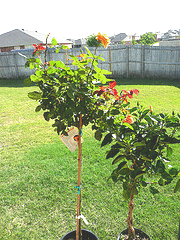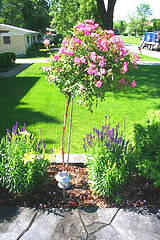A few simple steps to plant your rose standard
When you get your rose standard home wrap the crown in a moist sheet or burlap sack. This will prevent dehydration and encourage the buds to break. Keep the crown wrapping moist while you prepare to plant. If you purchased a dormant bare root rose, you may even want to leave it wrapped and stored in the shade until the leaf buds swell, since rose standards sometimes take extra time to leaf out. If you plant the standard and the buds do not begin to swell after 10 to 14 days in sunshine and warm moist soil, wrap the crown again. Keep the wrapping moist and check frequently for bud break. Remove the covering immediately after the leaf buds have swelled full or begin to break open.
Proper planting gives your rose standard the best chance of a long and healthy life. Most roses require at least 6 hours of full sun, but all day sun is best. Good soil and adequate moisture are just as important. To reduce fungus, if possible plant in a site that gets a gentle breeze to increase air circulation. And don’t crowd your plants, give them plenty of their own “air space”. Being elevated, tree roses will receive good air circulation, but should be spaced 3 to 5 feet apart in general. Check the expected mature width of the crown and plant accordingly. Hardy disease resistant varieties can be planted so the crowns meet each other at maturity or even overlap if you prefer. More susceptible varieties should be allowed a bit of space between. Larger weeping tree roses should be space up to 6 feet apart.
For bare root roses (no soil, not in a pot) soak the roots in a bucket of water while preparing the planting site. You can soak them up to 12 hours. Then dig a hole wider and deeper than the size of the roots, at least 18” wide and deep, and up to 24”. You can not dig a hole too big, but too small will crowd the roots. And roses do not like wet feet, but they do like lots of moisture. A deep hole will provide good drainage. This is especially important if you have clay or compacted soil that will trap water at the bottom of the hole. If you have sandy or loamy soil, 18” deep should be adequate.
Test the hole depth by placing the rose tree in it. Holding the bud union (the “bump” that joins the stem and the root stock) at ground level, the roots of a bare root plant should not touch the sides or the bottom of the hole. Sprinkle 1/2 cup of bone meal or superphosphate around the bottom of the hole to stimulate root development. Add compost to the soil you removed, a couple shovels full, and if your soil is clay also add peat moss in the same amount. You may also add extra NATURAL nutrients to the soil, an additional 1/2 cup bone meal and blood meal, and a cup of cottonseed meal. (Chemical fertilizers will burn new roots.) Mix it well, and add a small amount to the hole.
It is wise to test your soil before planting roses. They prefer a neutral soil, or slightly either way acidic or alkaline. If you are planting in acidic or clay soil, add a handful of lime when amending the soil.
Working the amended soil in with soil from the bottom and sides of the hole, form a mound on the bottom of the hole to fit the bare roots over, continuing to add more amended soil and working in soil from the sides until the mound is large enough to support the plant so the graft, or union is just above ground level. If you are planting a potted rose, add enough amended soil back into the hole to place the union just above ground level. As the loosened soil settles, the plant will settle lower, leaving the union at ground level. Carefully arrange bare roots so that the are not tangled or folded. Start adding amended soil, working it in lightly around the roots by hand, until the hole is about 3/4 full, then tamping the soil down lightly. Fill the hole completely with water and let it soak in, then fill again. Add more soil to fill if necessary as it settles.
In cold climates, the lower graft of a rose bush (trunk grafted to the root) is often planted below the soil level to protect the graft. This can sometimes encourage suckering. Since a rose standard has two grafts which cannot be protected underground, there is no advantage to burying the lower graft. The entire tree rose will have to be protected from winter anyway.
The standard must be staked to prevent swaying in the wind, which can damage the graft. And the trunk is not strong enough to support the rose grafted to it, which can cause the trunk to snap. Use a metal stake since a wood stake will rot. Metal fence stakes work well, and plastic coated will prevent rusting. Use a stake long enough to drive in 12 inches, plus the length of the trunk. Additional length protruding up into the crown will allow you to tie the crown to the stake also, which is particularly helpful in windy areas. The crown will not be able to moved enough by the wind to snap it off the trunk. The stake should be installed on the south side of the tree. It may seem a small matter, but in will in fact shade the trunk enough from the strongest sun to minimize the possibility of sun scald to the trunk. Use at least three strong, flexible plant ties along the trunk to secure it to the stake. That well keep the trunk straight. Do not tie it so the trunk is bent like the one pictured here. Loop your ties in a figure eight, one loop around the stake, one around the trunk. You should be able to find strong but flexible ties of all sorts at your garden center. Cut to length Soft Tie, Tender Ties, etc etc.
Now trim the canes (crown stems) back to about 6-10 inches and remove any damaged canes. If the canes are twice the size of the roots, there will not be enough root to feed the plant and the rose will grow spindly. Cut just above outside buds on the canes, cutting at an angle with a sharp rose pruner Each standard should be pruned according to the instructions for the variety that is grafted to your standard. You may, however like to adjust to your preference for a tree rose. Perhaps you would like the crown quite rounded, or a wide oval, or a more natural form.
Spread a thick layer of mulch around the tree rose to prevent splashing water. Water deeply every 4 or 5 days. You do not need to fertilize yet, the organic amendments you mixed into the soil will feed your rose slowly as it becomes established. A chemical fertilizer can burn new roots. Tree roses often need extra time to leaf out. As previously mentioned, to encourage bud break and to keep the stems from drying, you may cover the crown with a damp sheet or burlap sack. Cover the crown loosely, and carefully so as not to break branches. Keep the cover moist and check frequently. The cover must be removed immediately after the leaf buds break open.
As leaves begin to show in 3 to 6 weeks, spray the stems, leaves, and surrounding soil with a fungicide for black spot. If your grafted rose is a disease resistant shrub rose, spraying may not be necessary. Follow the care instructions for the variety that is grafted to your standard. Once your tree rose is established, the only difference is care is to remember that your tree rose may feed a bit more heavily that a shrub rose. Most gardeners feel that extra water and fertilizer are used simply because it has further to travel to get to the roses bush. But obviously, the trunk itself is feeding too.

